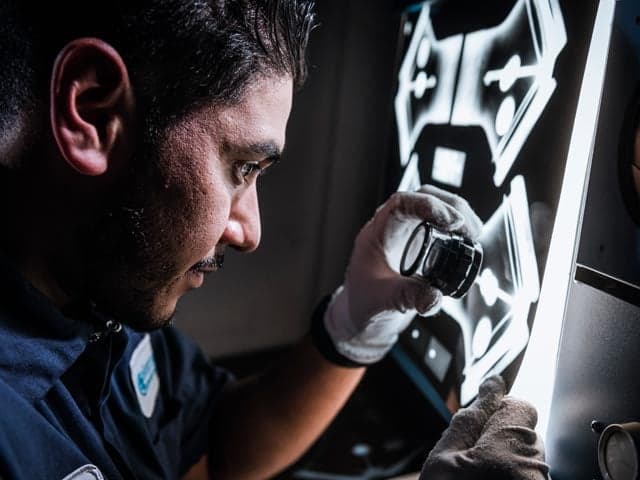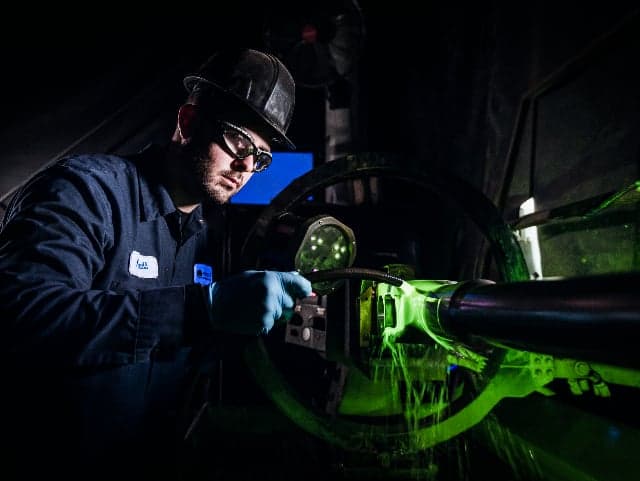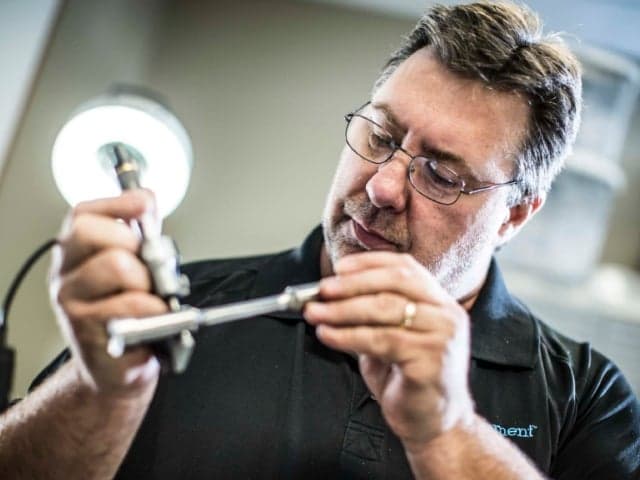Non-Destructive Testing (NDT) and Inspection Services
Ensure your products' integrity and reliability without compromising their structure with Element's Non-Destructive Testing services. Whether you need on-site field testing or comprehensive laboratory analysis, our certified experts provide accurate inspections that detect flaws early, meet regulatory requirements, and minimize production downtime.
Why Element are global leaders in Non-Destructive Testing
Element's Non-Destructive Testing (NDT) covers a broad group of techniques used to evaluate the properties of materials, components, assemblies, parts, products, welds, and systems without affecting their integrity. Our services comply with a variety of industry standards, unique customer requirements, government contracts, and military specifications.
From nuclear reactors to bridges and aircraft fuselage, our NDT services guarantee regulatory standards are met before components enter service. Our experts assist clients in projects ranging from material analysis and product qualification to quality assurance and audit programs, detecting cracks, porosities, welding defects, and evaluating material properties both on-site and in our laboratories.
Our testing methods include:
Services

Ultrasonic Testing (UT) Services
Detect hidden defects with Element's ultrasonic testing services. Our expert teams provide both contact and immersion UT inspection to verify component integrity, meet standards, and prevent failures.

Radiographic Testing (RT) and Inspection Services
Element provides radiographic testing and inspection services to detect hidden defects in critical components. Our advanced NDT methods meet industry standards, ensuring compliance, efficiency, and reliable quality verification.

Magnetic Particle Inspection (MPI) Services
Element's experts carry out non-destructive magnetic particle inspection tests to check for surface and near-surface discontinuities in ferrous metals.

Industrial Computed Tomography
Industrial computed tomography (ICT) at Element provides high-resolution, non-destructive testing for precise defect detection, 3D measurement, and quality assurance across industries.

Eddy Current Inspection
Eddy current inspection delivers precise non-destructive testing for metallic structures, including heat exchangers and aircraft parts. Detect flaws and ensure quality with Element's advanced testing solutions.

Liquid Penetrant Inspection (LPI)
Element's liquid penetrant inspection identifies surface flaws with precision. Our experts provide reliable, cost-effective testing for aerospace, nuclear, and commercial applications, delivering accurate results to support compliance and quality assurance.

X-Ray Diffraction (XRD) Analysis
X-Ray Diffraction (XRD) analysis is a non-destructive testing method that identifies crystalline phases and chemical composition, supporting precise material characterization for industries requiring detailed structural insights.

Visual Inspection Services
Expert visual inspection services to detect defects, inconsistencies, and surface flaws in materials and structures. Enhance quality control and compliance with our Engaged Experts and industry-approved standards.

Spray Dryer Crack Testing and Inspection
Element's spray dryer crack testing helps food, flavor & pharmaceutical industries detect defects quickly, reduce costs, and maintain safety with advanced inspection methods.
Sebastien Jeuch
Sebastien Jeuch
Justin Riebesel
Quality Director Americas & NADCAP
Rick Gerads
Non-destructive Testing (NDT) Level III Expert & Technical Specialist
Joshua Allen
NDT Level III Technician
Andrew Furgason
Non-Destructive Evaluation Department Manager
Blaine Denson
Immersion Ultrasonic and Eddy Current Department Manager
Neal Ferguson
Director, Global Accounts - Energy
Your Challenges, Our Solutions
Regulatory compliance concerns
Production downtime issues
Early flaw detection needs
Standards we test to and components we test
Materials we test include, but are not limited to, the following:
- Metallic materials (ferromagnetic and non-ferromagnetic)
- Composite materials
- Raw materials (sheet, plate, bar, pipe)
- Castings and weldments
- Forgings, machined and stamped parts
- Large components (up to 12,000 pounds)
- ASNT
- NAS 410
- EN4179
- EN473
- ISO 17025
- ISO 9001
- NADCAP
- Industry-specific standards and unique customer requirements
Accreditations:
- ISO 17025
- SO 9001
- NADCAP
Approvals:
- Airbus
- Leonardo
- Meggitt
- Pall Corporation
- Rolls Royce Deutschland
- Rolls Royce PLC (UK)
- Sikorsky
- UTC (Goodrich)
- And many more
Why Choose Element

Complete testing portfolio
Field and laboratory options
Certified technical expertise
Global testing capacity
But don't just take our word for it
See what others have to say about partnering with Element
Element Experts at your service
Sebastien Jeuch
Sebastien Jeuch
Justin Riebesel
Quality Director Americas & NADCAP
Rick Gerads
Non-destructive Testing (NDT) Level III Expert & Technical Specialist
Joshua Allen
NDT Level III Technician
Andrew Furgason
Non-Destructive Evaluation Department Manager
Blaine Denson
Immersion Ultrasonic and Eddy Current Department Manager
Neal Ferguson
Director, Global Accounts - Energy
Our NDT Expert Training Program
Element recognizes the importance of having qualified and highly trained technical staff to oversee our non-destructive testing methods. We adhere to clearly defined certification systems that have been established to guarantee the highest possible standards of expertise on the part of our personnel.
We operate two internal NDT training centers within Element that specialize in teaching non-destructive testing to ASNT, NAS 410, EN4179 and EN473, and have EASA 145 approval and BAE systems approval for level 3.
We provide NDT training for the following areas:
- Practical testing
- System tests and calibration of testing equipment
- Selection and implementation of testing methods
- Development and implementation of suitable testing methods
- Preparation of guidance documentation for testing processes
- Training of testing personnel
- Third-party certification of testing personnel
- Technical advice and level III support
- Tailor-made testing systems
- Non-destructive testing for defense

